Giant's Causeway |
|
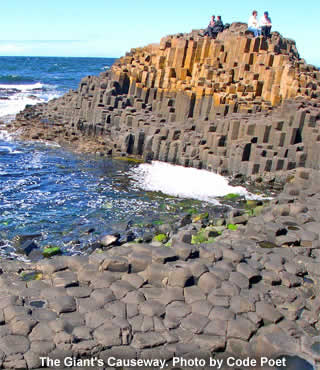 |
|||
One of nature's most unusual, perplexing creations |
|||||
Listen to this article |
|||||
|
|||||
Around 50 million years ago, in an area on the north-east coast of what we now know as Northern Ireland, there occurred some extremely unusual volcanic activity. Molten lava spewed up to the surface and, as it cooled, it formed into a series of 40,000 interlocking columns. These strange pillars are mostly hexagonal, with flat sides. They lead off from the shore and into the sea, like a series of stepping stones. |
|||||
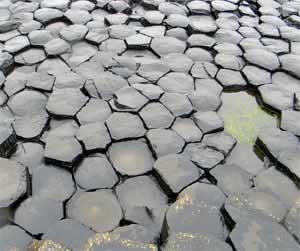 The hexagonal stepping stones that make up the Giant's Causeway. Photo leateds |
|||||
The overall effect looks less like the result of a natural event, and more like a carefully crafted staircase. This is probably what started the ancient legend of the Giant's Causeway, which gave the place its name. |
|||||
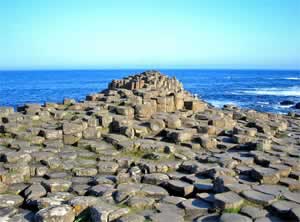 Like a giant staircase into the sea! Photo Effervescing Elephant |
|||||
The story begins with a giant by the name of Finn McCool, who was known as the greatest warrior in Ireland. He wanted to challenge his counterpart in Scotland, another giant called Benandonner. Unfortunately, there was no way to cross the ocean to meet him, so Finn built his own pathway of stepping stones. But as soon as Finn reached Scotland and saw how big Benandonner actually was, he ran all the way home, terrified. The Scottish giant retaliated by crossing the new bridge to Ireland, and heading straight for his enemy's house. Luckily, Finn's wife was a crafty giantess and, as her husband curled up in bed, scared stiff, she told Benandonner not to wake the baby. The Scottish warrior looked at the bed, and saw a giant that was nearly as big as himself. If this was just the baby, he thought, how big would the father be? Benandonner fled back to Scotland as quickly as he could, tearing up the causeway behind him. |
|||||
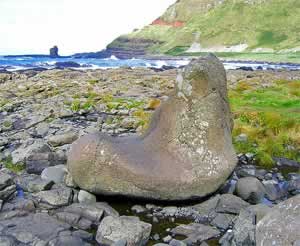 It is claimed that this rock was Finn McCool's Boot! Photo Pete Fordham |
|||||
|
|||||
The strange rocks were discovered in the 17th century, and came to international attention when an 18th century artist called Susanna Drury made several watercolour paintings of them. The site became especially popular with tourists after a direct tramway was built in the late 1800s. The line was notable for being powered exclusively by renewable hydroelectricity. Unfortunately, it was closed down shortly after World War II. Today, you can arrive by car or bus, along the scenic coastal road. Once you get there, you can investigate all the different formations. The various shapes all have descriptive names like "The Giant's Harp", or "The Camel's Hump". |
|||||
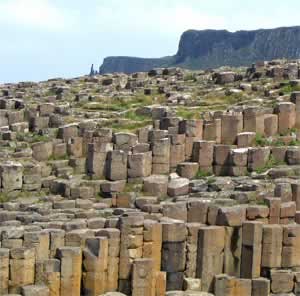 Volcanic rocks making up the Giant's Causeway. Photo Public Domain |
|||||
Future plans include a new visitors centre next to the rocks, but in the meantime tourist information is available at the nearby Causeway Hotel. Here you can find out about the area's rare plantlife, or the various kinds of seabirds you can see darting around the rugged coast. The speedy little things are quite tricky to photograph, so best of luck! |
|||||
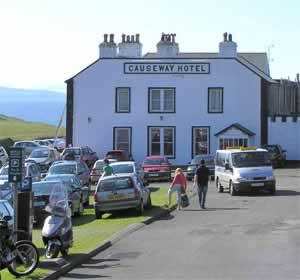 Causeway Hotel. Photo Kenneth Allen |
|||||
While you're in the area, it's worth investigating a few of the coast's other attractions. To the east is the hair-raising Carrick-a-Rede Rope Bridge, which is thankfully safer than it looks. To the west is the Old Bushmills' Distillery, the oldest legal whisky-producer in the world. Alternatively you can just explore the cliffs, which are perfect for walks and picnics. |
|||||
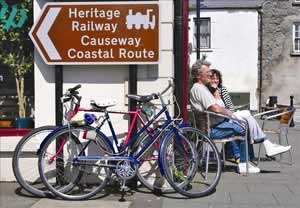 Exploring the Causeway Coastal Route. Photo Northern Ireland Tourist Board |
|||||
There are other places around the globe where you can see similar rock formations, but The Giant's Causeway is surely the most impressive. In 1986 it was awarded as Northern Ireland's first and only World Heritage site. |
|||||
|
|||||
|
|||||
The Giant's Causeway Stones are managed by the National Trust and open all year round. The visitors centre (currently at the Causeway Hotel) is open daily, 9.30am to 5pm. 44a Causeway Road, Bushmills, County Antrim BT57 8SU. Tel: 028 2073 1582 |
|||||
The Giants Causeway and Bushmills Railway runs on Saturdays and Sundays, plus daily from July to August. Trains depart between 11am to 5pm (hourly). Return tickets cost around £8 for adults, £6 children. Giant's Causeway Station Runkerry Road, Bushmills, BT57 8SZ. Tel: 028 2073 2844 |
|||||
|
Pocket Britain is optimised for use on a smartphone or tablet with internet access. All content is subject to copyright. All reasonable methods have been used to ensure information supplied is accurate at the time of publication. However, it is advisable to check information before relying on it. Privacy Policy |